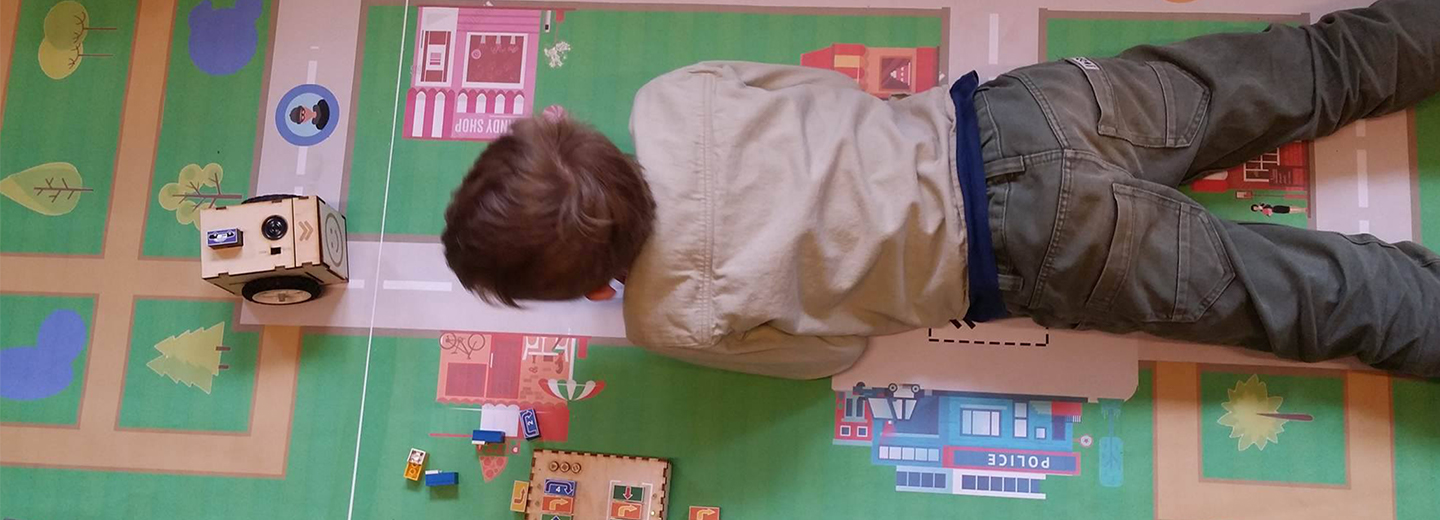
Coding taught using Lego
The Danish Ministry of Education is introducing the subject Technology Comprehension into selected primary and lower secondary schools so that children become competent in disciplines such as coding, sensors and 3D printing. At the same time, researchers are developing pedagogical tools to help the youngest pupils develop an interest in technology.
Af Birgitte Dalgaard, bird@tek.sdu.dk
The small, rolling robot is catching criminals while barking like a dog. By arranging Lego bricks in the right order on a plate, children can code the robot to go where the criminal is hiding. And the children think it is great fun.
- When we were testing the robot, we could see that the girls engaged with the task when the robot had a personality and an aim: for instance, a police dog who is hunting criminals.
- The boys are excited when they actually get their hands on the robot, says PhD student Bjarke Maigaard Pedersen from SDU Embodied Systems for Robotics and Learning.
From screen to Lego bricks
He has developed Bricko, a robot designed to move coding and programming away from the computer screen and into the hands of children as young as those in first and third class.
Bjarke Maigaard Pedersen hopes that the playful approach to technology can help do away with the schism where although in only a few years there will be a lack of engineers, only 2.6% of Danish 15-year-olds are planning a career in engineering.
In comparison, the average is 6.9% for the other OECD countries, according to statistics from Engineer the Future.
”We need to show even the youngest children that technology is exciting and fun before they become set in the notion that it's only for special mathematical geniuses
- The more senses that are involved in learning, the more likely it is to stick. When we tested the robot, the teacher observed that the children who aren't strong in mathematics, and normally withdraw during teaching, got completely involved in the project, says Bjarke Maigaard Pedersen.
On 1st March, the Danish Ministry of Education's three-year experiment with Technology Comprehension in schools got underway. 46 schools have been chosen to be guinea pigs for how Technology Comprehension can be implemented into compulsory teaching in schools.
- If more young people are to develop an interest in technology and become engineers, we need to show even the youngest children that technology is exciting and fun before they become set in the notion that it's only for special mathematical geniuses, explains Bjarke Maigaard Pedersen.
Each brick has a command
He has constructed Bricko based on Lego bricks, which children already associate with play and are completely comfortable with. Each colour of brick has a command: Move forwards, backwards, turn round, make a sound...
The bricks have each been ascribed with an ID. Each ID represents a programming command the robot can carry out. When the bricks are placed on the control plate, a microcontroller reads the IDs and sends the information via Bluetooth to the robot car. When the robot car receives the information, it can start carrying out the individual programming commands.
- Coding language on a computer screen is incomprehensible to a child. Children can't deal with 400 lines of text in English, where if you put a comma in the wrong place the computer doesn't understand the command. The computer is a very unforgiving teacher, says Bjarke Maigaard Pedersen.
From abstract to concrete
The Bricko robot has been rolled out to children at Vestre School in Odense and at SDU's Technology School. At Technology School, children learn about robots, artificial intelligence and programming in their free time, and Bjarke Maigaard Pedersen works there as a volunteer.
- When helping children understand technology, our experience has been that it's important to make the abstract as concrete as possible. To convert technical problems into a physical form so the children can work together to find out what is possible, concludes Bjarke Maigaard Pedersen.
- When children have a Lego brick in their hand and they can control a robot by putting the bricks together in different ways, they have a solid physical foundation for understanding the abstract theory. At the same time, children become more engaged if they see an aim with the task - such as hunting criminals.
About the experiment with the subject Technology Comprehension
In all, 46 schools are participating in the three-year experiment.
The Danish Ministry of Education will establish and facilitate a nationwide and several regional competence networks for schools who are interested in working with Technology Comprehension, including schools for whom there was not enough space in the experiment. The networks can facilitate work with materials and experience from the experiment schools.
Anyone can follow the experiment at emu.dk.
Source: Danish Ministry of Education
Meet the researcher:
Bjarke Maigaard Pedersen is team responsible at Teknologiskolen, which is a technology leisure for children and young people. In addition, he is a PhD student at SDU Embodied Systems for Robotics and Learning, where he works to develop concrete solutions for how teachers can excite school students to learn about coding and sensors and other technology.